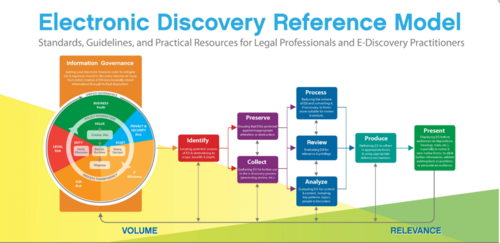Electronic Discovery Reference Model (EDRM)
The EDRM (Electronic Discovery Reference Model) is an eDiscovery workflow and framework that the legal and IT fields accept as broad outline for the steps to consider throughout the eDiscovery lifecycle in the United States. The EDRM model has been around since 2005, and has stood the test of time. The electronic discovery reference model was originally designed by George Socha and Tom Gelbmann. They transferred ownership to Duke University Law School and the diagram is now owned by Mary Mack and Kaylee Walstad (previously at ACEDs). More information on this useful diagram can be found on edrm.net. This discovery model is not necessarily designed to be a linear and static workflow. E-discovery processes are dynamic, and steps can be completed in any order, with the option of coming back to earlier stages as needed.[1]

source: EDRM.NET
The Stages of the EDRM[2]
With the history and description of the EDRM out of the way, let’s look at the nine stages of the model:
- Information Governance: It goes without saying that if legal teams are going to be able to effectively process electronically stored information (ESI), this information first needs to be captured and stored properly. With this in mind, the EDRM places great emphasis on information governance—the comprehensive management of data through set procedures, processes, and policies. Information governance is such a crucial component of successful eDiscovery that the EDRM has created a separate model dedicated entirely to it. It’s called the Information Governance Reference Model (IGRM)
- Identification: Organizations are legally obligated to preserve any ESI that might be relevant to a legal matter. But knowing what information will end up being important isn’t always easy at the start of the eDiscovery process. With this in mind, the first stage of the EDRM is “Identification,” and includes any activities—such as case reviews and interviews—that assist in identifying key pieces of electronic information that are likely to be important to a case down the line.
- Preservation: Once crucial ESI has been identified, the next step is preserving that evidence for litigation. Failing to do so can result in what is officially known as spoliation—the tampering or destruction of evidence. One of the most common ways to preserve evidence and prevent spoliation is to place data on legal hold. By doing this, legal teams effectively “freeze” information and forbid IT (or any other department) from deleting that information.
- Collection: Once evidence has been preserved by placing it on legal hold, legal teams now need to collect that information in a way that will allow them to use it throughout the legal process. For instance, what if a key piece of evidence is a conversation that happened between two employees on an enterprise collaboration platform? The legal team would need a way to collect this information and present it in a way that’s defensible, meaning that the authenticity of the data is beyond question.
- Processing: The above takes us directly to the next stage, “Processing”. Collected evidence now has to be processed ahead of attorney review. This means “cleaning it up” by doing things such as deleting irrelevant data, converting files, and ultimately collecting it all in a single folder. Many organizations now make use of eDiscovery platforms like those offered by Exterro, Logikcull, and Relativity to simplify and streamline this process.
- Review: “Review” is not only one of the most important stages of the EDRM, it is also one of the most costly. Once all this ESI has been collected and processed, it has to be reviewed by legal teams to understand how it relates to the case at hand. With the average hourly rate of a lawyer being what it is, and modern legal cases easily containing 6.5 million digital pages, around 80% of litigation cost in the U.S. goes towards document review—a total of $42 billion a year!
- Analysis: As one would expect, the “Analysis” stage involves evaluating ESI for particular use during a legal matter. This means looking at the content and context, and according to the EDRM itself, identifying “key patterns, topics, people, and discussion.” It should be added that, while analysis is its own distinct stage here, every component of the EDRM obviously involves its own form of analysis.
- Production: With crucial ESI identified and incorporated into a legal strategy, it’s time to produce this evidence in a way that makes it usable during formal legal proceedings. In other words, legal teams need to consider how they will present this evidence in a defensible way. With a social media or website post, for instance, the associated metadata would need to be provided in order to prove authenticity.
- Presentation: Once legal evidence has been produced, all that remains is presenting it during a legal proceeding like a trial or deposition. Just as ESI has started to dominate the discovery process, presentation has also shifted away from paper towards more digital presentation.
References
- ↑ What is the Electronic Discovery Reference Model (EDRM)? Digital War Room
- ↑ What are the stages of the Electronic Discovery Reference Model? Page Freezer
